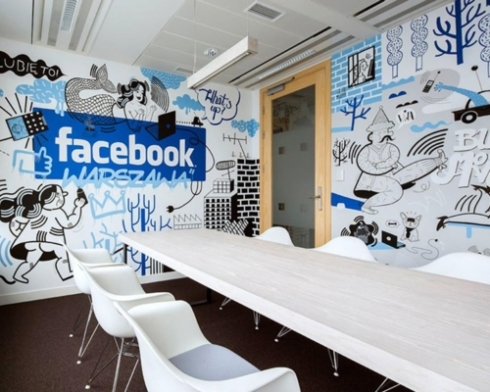12 Surprising Ways Facebook, Google And Disney Motivate Their Teams (And How They Reward Them Without Using Money)
Money is not the solution to all of your business woes, especially when it comes to your people. You may use cash as a motivator, but there are downsides that you need to know about.
Do you know how to motivate teams to do more?
Many managers will claim that a little bit of money goes a long way in motivating their teams. And there’s no denying that money helps motivation.
The problem comes when you start to see money as the only way to prop up motivation in the workplace. You start ignoring all of the staff motivation tools at your disposal and instead rely on cash to solve your problems.
But that doesn’t help with engagement. In fact, there are plenty of studies that demonstrate just how low money falls on the list of key motivators for staff.
A study published in the Journal of Vocational Behavior looked at the issue in more detail. A complex meta-analysis of ways to motivate staff showed that money doesn’t have the power that you may think. The study pulled together 120 years of research that looked at over 15,000 people.
And it found something remarkable.
It discovered that pay level correlated with job satisfaction levels in less than 2% of cases. Plus, the results were consistent no matter where you are in the world.
Other studies have examined the effect of money on intrinsic and extrinsic motivation. In particular, offering monetary incentives for work lowers intrinsic motivation by over 30%.
On the other hand, you’re not exactly going to get people to work for free. Money has to play some role when it comes to ways to motivate staff.
It just may not be as large a role as you think.
In this article, Great Managers deep dive into the subject. We’ll look at the good & bad of using money as a motivator. Then we’ll look at other key motivators and some fun ideas to motivate teams that don’t require money.
All of this in an effort to answer the big question.
Does money motivate employees?
The Pros and Cons of Using Money as a Motivator
Before looking at the pros and cons of using money as one of your ways to motivate staff, let’s look at the various ways that you can do it.
Salary is the most obvious. A raise is often seen as a reward for hard work and almost comes as standard as part of a promotion. But there are plenty of other ways that you may use money to motivate teams.
You may have incentive schemes that offer cash bonuses based on performance. Or, you may offer your people stock options or operate a profit sharing scheme.
All of these things can and will motivate your people…to an extent.
The Pros
Unfortunately, money is not a perfect solution. There’s both good and bad in using money to motivate teams.
Let’s look at the pros first.
Pro #1 – It’s Straightforward

This is perhaps the chief reason why managers use money to try to motivate people. There’s no challenge in giving somebody a raise or a cash bonus. As long as you have the budget for it, you can just throw money at somebody and that’s it.
There’s no need for personalisation and you don’t have to know much about the person. That simplicity makes money a favoured method for highlighting individual achievement too. A monetary incentive scheme can reward people for good work and provide employees something to aim for.
Pro #2 – You Get Short-Term Productivity Gains
Using money can help you motivate employees to work harder in the short term.
For example, let’s say that you have a difficult project with a tight deadline. In such cases, you may not be able to use many staff motivation tools. Time is too short and you can’t spend it on any of the methods that this article covers below.
The use of monetary incentives can give your people the short-term motivational boost needed to push through such a project. Something like a bonus scheme can raise productivity beyond normal levels until the project concludes.
Pro #3 – It Offers an Element of Control
The right monetary incentive scheme can offer your people a sense of control over their financial situation.
Bonus schemes and commission structures both offer good examples of this. An employee may see these as ways to top up their salary to help them achieve something in their personal lives. They know that if they work harder or complete certain tasks, they’ll be able to boost their income.
This level of control leaves the decisions in the hands of your people. They can make work decisions based on the financial incentives on offer.
The Cons
Ease of implementation and short-term productivity gains make money an attractive choice.
But there are plenty of downsides to using money as a motivator. These are some of the cons.
Con #1 – It’s Addictive
When you rely on money as one of your chief ways to motivate staff, you set a precedent.
Your people start to expect monetary rewards in return for hard work. In essence, they become addicted to your incentive schemes. If you take away the monetary reward, you’ll often find that your people stop giving their all. They’ve become accustomed to your use of money as a motivator and can no longer motivate themselves when money isn’t on offer.
This can prove disastrous for your business. Your organisation will have to budget specifically for the monetary incentives needed to keep your people going. And you can’t take those incentives away and expect to get the same returns.
This “addiction” works both ways too. Many managers become glued to the idea of using money to spur motivation in the workplace. They either have no other ideas or think that nothing else will work as well as cash.
In all cases, this costs organisations money and drastically alters the working environment.
Con #2 – Monetary Incentives Discourage Innovation

Most managers will tell you that they want their people to be innovative and creative. After all, new ideas help organisations to avoid stagnation.
Using money as a motivator does not spur on this innovation. Instead, it encourages your people to comply with whatever it is they need to do to earn the money.
Think of it like this.
Let’s say you have a sales team and you’re providing a monetary incentive to anybody who hits a set sales target. Your team will put all of its focus into hitting that target. But in doing so, they’re not coming up with any fresh ideas that could benefit the organisation. They’re just complying with a target.
If you extend such schemes throughout the entire organisation, the problem deepens. Innovation and new ideas don’t have the same tangible rewards as hitting targets. Of course, that means people won’t put any thought into those aspects of their work.
Con #3 – Money Doesn’t Solve Culture Issues
Money may give your people a short-term boost to deal with immediate problems.
But when it comes to how to inspire a team, money is almost a non-factor. People expect to receive payment for their work. But they also want to work in an environment that makes them feel happy to do the job. They need their work to have purpose and they want to work with great colleagues.
Perhaps most importantly, they need a leader who knows what it takes to be a Great Manager.
All of these key motivators have one thing in common:
Money doesn’t affect them.
It doesn’t matter how much money an organisation makes. If people hate working for it, motivation levels will always fall. And a monetary motivator will only offer a short-term boost before the same issues with culture and purpose rise up again.
Money doesn’t deal with the emotional wellbeing of your people. It doesn’t help you to motivate them based on their personal and career ambitions.
Relying on it for every motivational issue that occurs means you’re ignoring the root causes. Your people take notice and become less productive because they know that money is the only thing that seems to matter.
How the Big Players Do It

The above covers some of the good and bad of using money to motivate people.
In short, money is one of the short-term ways to motivate staff. But you can’t rely on it to deal with your organisation’s cultural issues.
Yet it’s these cultural issues that often have a larger effect on motivation.
Some of the world’s largest organisations, such as Disney and Facebook, recognise this too. And they’ve come up with plenty of staff motivation tools that don’t rely on monetary incentives. Let’s look at a few examples of how the big players confront motivational issues.
Disney’s Shock and Awe

For now, let’s look at a story from way back when Walt Disney was still making movies.
One day, Walt told one of his employees, Mike Vance, about an issue that he had. His brother would no longer finance Walt’s films, so he needed to figure out how to get more money from Disneyland.
Mike got to work. He pulled together a team containing seven people and they started by looking at the park schedule. At the time, Disneyland only stayed open for five days per week – Wednesday to Sunday.
Naturally, the first idea was to open the park on the two days during which it was usually closed. But the team didn’t think that would work. Nobody would want to come.
That’s when they came up with a great idea – The Magic Kingdom Club. This club would comprise solely of corporate members. It also allowed these members to give discounted Disneyland tickets to employees for Mondays and Tuesdays.
The plan worked to perfection. In fact, it generated so much money that Walt Disney sent Mickey Mouse himself to the doors of each team member on Christmas day.
Mickey presented each with $25,000 and a note from Walt that said the following:
“It’s fantastic. You’re fantastic. Do it again.”
All seven of the team’s members went to the office that very afternoon to come up with more ideas.
Now, you’re probably looking at the money that Disney gave to his people. There’s no doubt that it was a nice surprise.
But that surprise is actually the key point. Nobody on the team expected a reward of any kind for just doing their job. But they received one. And it came with a handwritten note of congratulations and gratitude from Walt Disney himself.
It’s a shock and awe tactic. The money is only secondary in this story. It’s the gesture of gratitude that’s the most important thing to take away from the tale.
Show your people that you really care about them in order to motivate them. Sure, an unexpected monetary bonus can help. But so can other gestures, such as a thank-you or extra holiday time.
Google’s Workplace Culture

The above story combines monetary incentives with shock and awe motivational tactics.
But it’s also only a short-term solution. You’ll need more long-term staff motivation tools to keep your employees happy. And that’s where it’s a good idea to look to one of the largest organisations in the world – Google.
Google is widely-renowned for focusing on creating a great workplace experience for its people.
Monetary compensation is certainly a part of the package. But it’s the overall culture that the company creates that has a much larger effect on its people. Let’s look at two staff motivation tools that Google uses that show it doesn’t try to rely on money to motivate its people.
Tool #1 – Personalised Perks
Google goes to greater lengths than any other organisation when it comes to employee perks.
For example, Google offers financial support to its employees if they want to adopt children. It also offers 18 weeks’ worth of full pay to those who go on maternity leave. The company even covers the cost of $500 worth of take-out meals for the first three months of the baby’s life.
That’s not all. The company offers an array of services, such as dry cleaning, a car wash, and on-site fitness facilities. Plus, meals are all free in the organisation’s cafeterias.
All of these may seem like monetary incentives at first. But look a little bit deeper and you’ll see the difference.
Google isn’t just offering a bit of cash in return for hard work. It’s providing an array of services that allow its people to deal with the many personal issues that they face. This, in turn, improves motivation in the workplace.
Google recognises the importance of spending time with a newborn child. It also knows its people may struggle to complete some tasks during the day, so it offers relevant services on-site.
Google constantly demonstrates that it cares about its people. That’s why it’s often rated as one of the best organisations to work for by its employees.
Tool #2 – Constant Transparency
A Center for Generational Kinetics survey unveiled some interesting information on workplace transparency.
Only 55% of people think their managers are fully transparent. The rest think important information gets hidden from them. And that means they distrust their managers, which affects motivation in the workplace.
Google goes to great lengths to use its transparency as one of its key staff motivation tools.
Every quarter, the company’s board holds a meeting to discuss future strategy. Just a couple of weeks after that meeting, these same materials get shared with all of the company’s employees.
This means that everyone knows what Google wants to work on and where it intends to go.
It’s a simple act that allows Google’s people to engage with the organisation’s vision.
Google goes a step further with its annual employee feedback surveys. The organisation releases the results – anonymously, of course – for all to see. Then, it takes action on the feedback and shares the results.
All of this builds trust within the team, which leads to better results.
Facebook’s Flexibility

Another of the world’s tech giants, Facebook also places a great focus on ways to motivate teams.
One of its most creative ways to motivate employees lies in the flexibility that it provides.
It all starts with mobility. Most organisations provide desktop computers and assign office space to their people. Facebook does the same with office space. But it instead provides laptops that allow its people to move wherever they want to work.
If the office gets too loud, people have the freedom to unplug and move to the cafeteria or find a small nook away from the hustle and bustle.
There are also libraries and meeting rooms in Facebook’s buildings that employees can use.
Here’s the point. Facebook doesn’t punish its people for not working at their desks. It understands that people work in a variety of ways. By accounting for this, it keeps its people happy and boosts motivation in the workplace.
But the flexibility doesn’t end there. Facebook also accounts for its people’s personal needs.
For example, it doesn’t enforce rigid office hours. Again, this shows a great understanding of the differences between people. Some prefer getting in bright and early, whereas others are night-owls who work best during the evening. Facebook uses flexible working hours as one of its key ways to motivate staff.
On top of that, employees have the option to work from home whenever needed.
Facebook offers all of this within reason. People who take advantage of Facebook’s flexible staff motivation tools may run into issues. But the fact that Facebook offers such flexibility is a massive motivator that doesn’t require money.
A Few More Examples
Those are some stories and creative ways to motivate employees from three major organisations. But plenty of other large businesses have their own ways to motivate staff.
For example, Airbnb allows its people to bring their pets to work. That’s a massive plus for anybody who’s afraid of leaving an animal at home for hours at a time. In fact, this little perk makes keeping a pet with a lot of needs possible for its employees.
Mindcandy looks towards more fun ideas to motivate employees. The entertainment group uses a huge red slide to connect its office’s top and bottom floors. There’s even a treehouse for its people to explore. Plus, it holds a “Beer O’ Clock” hour every Friday.
So, what can you take from all of this?
All of these companies have different ideas when it comes to motivating staff. But all of these ideas have to common threads:
- They focus on creating an enjoyable and productive workplace.
- They demonstrate an understanding of the personal needs of employees.
It’s through taking care of your people that you will keep them motivated. Money is just one of many staff motivation tools. Moreover, it’s perhaps the most ineffectual, at least when it comes to long-term productivity.
These techniques focus on the long-term goals of creating a great workplace and keeping employees engaged. Unsurprisingly, all of the organisations mentioned above have also achieved great success.
Ways to Motivate Teams Without Using Money
By now, you’re getting a good idea of how to be a motivational leader. You know it’s not all about money. Instead, it’s about the culture that you create and the staff motivation tools that you put in place.
The world’s largest organisations offer some interesting ideas. But many of them may be out of reach for you.
That’s okay.
There are plenty of creative ways to motivate teams that don’t require you to rebuild the office. Here are ten examples to get you started.
Technique #1 – Celebrate Your Wins

Every time your team achieves a goal or reaches a milestone is a cause for celebration. However, many managers just ignore these achievements entirely.
This means they’re not showing any gratitude to their staff.
Failing to celebrate is particularly damaging when your people have gone above and beyond. If you don’t acknowledge the success, you’re not inspiring them to push hard with the next project. Instead, you’re telling them that what they’ve just achieved doesn’t matter.
That’s not how to inspire a team.
So, celebrate the wins, no matter how small they may seem. Something like Mindcandy’s Friday happy hour works well here. But there are many other ways to celebrate. A small office party at the end of the week or a pizza at lunchtime shows that you care. Better yet, these small celebrations bring your people together and strengthen the bonds they have with one another.
Technique #2 – Avoid Boring Routines
Imagine the scene.
You come into work and you have a list of tasks to complete. This is the same list that you had for the previous day. And it’s the same list you’ll have for every day after today.
You’re stuck in a routine and the monotony threatens to destroy any motivation you once had.
It doesn’t sound very appealing, does it?
Yet so many managers allow their people to fall into boring routines. But this only encourages your people to achieve the bare minimum.
Occasional breaks in the routine can have a massive effect on employee motivation. Give people unique tasks that challenge their skills. Allow them to explore their creativity.
Sure, the routine stuff still needs to get done. But if that’s all your employees do, they’ll soon disengage.
Technique #3 – Encourage Mindfulness
Embracing mindfulness is one of the more creative ways to motivate employees. It’s also something that you may not have considered because it seems like it would have a negative effect on productivity.
Mindfulness is a simple concept. It’s the act of taking a step back and appreciating what’s going on around you.
And it can have huge benefits when it comes to your employees’ stress levels. That’s important because stress has huge effects on motivation levels. In fact, it costs the Australian economy about $10 billion annually.
Mindfulness allows people to unplug from whatever’s causing them stress so they can take a few moments for themselves. That makes it one of the most unexpected ways to motivate teams.
Technique #4 – Use Intrinsic Rewards
Debates still rage about the varying values of intrinsic and extrinsic motivation. Money is an extrinsic motivator because it provides a direct reward for an action. But with intrinsic motivation, the reward comes from the action itself.
That’s the sort of motivation that you need to encourage.
Intrinsic motivation comes from working on things that you care about and having great belief in an organisation’s goals.
That means that your organisation’s values, culture, and vision all affect it. If your people don’t believe in what they’re doing, there’s a limit to how hard they’ll work.
It’s not enough to have a vision. You need to ingrain it into every aspect of your culture. Make it clear and act upon it all times. This helps your people to care about the vision, which turns it into an intrinsic motivator.
Technique #5 – Embrace Creativity

Facebook’s flexibility doesn’t just provide for the personal needs of its people. It also allows them to express themselves creatively.
Here’s the key thing to remember. Everybody works in different ways. Some prefer to be part of a team environment at all times. Others may appreciate the opportunity to sequester themselves away to put some thought into new ideas.
The most important thing is that your organisation embraces creativity. Give people the opportunities that they need to explore new ideas. As importantly, take those ideas on board and implement the best of them. Demonstrating that you put new ideas into practice is one of the best ways to foster motivation in the workplace. Plus, it helps your business to avoid stagnation.
Technique #6 – Make Changes to the Scenery
You may not want to build a huge red slide like Mindcandy did. But that doesn’t mean that you can’t make some changes to the workplace scenery.
Even something as simple as rearranging the office or using brighter colours can improve motivation levels.
Natural light exposure is also a surprisingly big motivator. A study entitled Impact of Workplace Daylight Exposure on Sleep, Physical Activity, and Quality of Life took a closer look at this. It found that people who work in offices that have windows enjoy 46 minutes of extra sleep per night. More sleep means less stress, which means higher motivation levels.
Your office may not have windows. As such, taking your people outside for a little bit is one of the more creative ways to motivate teams. That little change of scenery, and addition of natural light, can have a huge effect.
Technique #7 – Always Explain the Why

Let’s imagine you have a task for your team to complete.
Many managers keep things as simple as possible when assigning this task. They just tell their people what to do and leave it at that.
But that’s not how to inspire a team. Your people will have no idea about the purpose behind the task, which makes them less likely to put their full effort into it.
Whenever you assign a task, take a few moments to explain the purpose behind it. Talk about how it will help the organisation to achieve a certain goal or what it will do for your people.
This plays into Google’s efforts with transparency. You’re helping your people see what you want to achieve, which motivates them because you’re being honest with them.
Technique #8 – Provide Regular Feedback
Did you know that 69% of people would feel motivated to work harder if they felt they received some recognition for their efforts?
Despite this, only 58% of managers believe they offer enough feedback to their people. And many of them may not offer as much as they think they do.
This needs to change. How you communicate with your people has an effect on motivation in the workplace. People want to know how they’re progressing and what they can do to improve. If you’re not offering feedback, you’re giving them nothing to focus on.
Try to hold weekly or monthly feedback sessions with your people. Use them to focus on what they’re doing well and provide some guidance where needed.
Technique #9 – Encourage Autonomy
In My Way or the Highway, Harry Chambers covered the topic of micromanagement. He says that 79% of people have felt micromanaged at some point during their careers. Of those people, 85% said that micromanagement damaged their morale.
The message is clear. Micromanagement has a negative impact on your people’s productivity.
Those who have what it takes to be a Great Manager recognise one simple thing. They need to trust the people that they hire.
Micromanagers don’t have that trust, which is why they’re constantly looking over their employees’ shoulders. Their people pick up on this and feel disheartened.
When you give somebody a task, trust that they have the skills to do it. They’ll feel much happier, which boosts motivation.
Technique #10 – Act According to the Golden Rule
The Golden Rule is a simple one that all managers must remember:
“Do to others what you would have them do to you.”
Never forget that you’re an employee too. Even if you’re at the head of your organisation, you’re still just as much a part of it as even your newest hire.
There cannot be one rule for you and another for everybody else.
Holding everybody accountable to the same set of rules is one of the better ways to motivate staff. But the Golden Rule extends further than that. Treat people with respect and encourage them to perform to the best of their abilities. You’ll motivate your people because they’ll see that you consider them your equals.
Keeping Yourself Motivated
The Golden Rule brings up an interesting point.
You are often one of the best staff motivation tools that you have at your disposal. Your people take their cues from you. If you treat them poorly or act by a different set of rules, they’ll grow to resent you.
But there’s more to it than that. Your people also look at the way that you carry yourself and how you approach your tasks. A negative attitude reflects onto your people, who carry that attitude into their work. But if you’re positive and motivated yourself, you’ll inspire the same feelings in others.
This may be one of the biggest aspects of how to be a motivational leader. And again, using your attitude to affect motivation levels requires no money at all.
But it does raise an issue:
How do you keep yourself motivated enough to motivate your people?
Here are a few tips from some of the world’s top leaders.
Oprah Winfrey – Be Ambitious With Your Vision
You may know Oprah Winfrey as a leading American television personality. But she’s also an entrepreneur who’s made innovative strides in broadcast and web technology.
She offers the following slice of motivational wisdom: “Create the highest, grandest vision possible for your life, because you become what you believe.”
Winfrey makes a simple point. If you don’t believe in yourself and what you’re doing, you’ll never feel motivated. For that, you need a grand vision to inspire you.
But how do you apply this to your work?
Try to think of every task in terms of how it helps you to take a step closer to achieving your vision. If you can figure out where the task slots into that plan, you’ll feel more motivated to complete it.
Steve Jobs – Know When to Make a Change
Routine can destroy your passion and motivation in the same way that it can negatively affect your people. Apple co-founder Steve Jobs knew this, which is why he always asked himself the same question every morning:
“If today were the last day of my life, would I want to do what I am about to do today?”
Jobs pointed towards his own mortality as a huge motivator. But he makes a brighter point here. Jobs’ question allows you to look closer at what you’re doing with your professional life.
He added: “…Whenever the answer has been “No” for too many days in a row, I know I need to change something.”
Your lack of motivation may stem from stagnation. Ask Jobs’ question of yourself every day and you’ll find out if you need to change something.
Steven Spielberg – Never Make Money Your Goal
Acclaimed film director Steven Spielberg has created some of the finest silver screen extravaganzas of the modern age.
And he agrees with the opinion that money is not the motivator that many people think it is.
“I’m not really interested in making money. That’s always come as the result of success,” he says. “But it’s not been my goal, and I’ve had a tough time proving that to people.”
Spielberg would likely say “no” if you asked him “does money motivate teams?”
Your reason for doing what you’re doing is your most important motivator. Whenever you start to feel unmotivated, remind yourself of that reason. Use it to give yourself the drive to keep pushing forward.
If money is your only driving force, you’ll often end up in bad situations. You’ll take on projects that you have no passion for just because they’re high earners. Again, your people see this lack of motivation and respond in kind.
The Final Word
We come back to the original question:
Does money motivate employees?
It can, to an extent. When used sparingly, monetary incentives can be a good way of achieving short-term goals.
But it doesn’t allow you to create long-term motivation in the workplace. For that, you’ll need more effective staff motivation tools.
Always remember that money is not the main motivator for most of your people. They have other goals, both personal and professional. They need to feel like their work has purpose and that you appreciate everything that they do. Your people want to innovate and create.
Help them to reach their goals and understand their purpose. That’s how you motivate teams without money.
Moreover, don’t forget that some of the world’s most successful people aren’t motivated by money. They find other ways to motivate themselves and success follows.
Are you struggling to motivate your people? If so, you’re not alone. After all, 65% of employees claim they’d prefer a new manager over a pay raise.
Don’t be one of those managers that your people want to replace.
Register for the next Great Managers webinar to learn even more about motivating your people.








